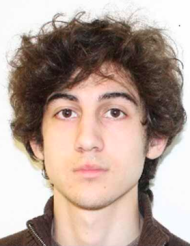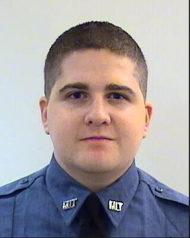[Updated at 3:51 p.m. ET]
BOSTON?Thousands of law enforcement officers are entering the 15th hour of a massive, door-to-door manhunt for a suspect in Monday's Boston Marathon bombings that wounded more than 170 people and left three dead.
A late-night police chase and shootout left one marathon bombing suspect?26-year-old Tamerlan Tsarnaev?dead and the other, his younger brother, on the run, police here said. One police officer was killed and another seriously wounded during the violent spree. The city of Boston and its surrounding areas have ground to a standstill as the manhunt continues in a 20-block radius of Watertown, with local leaders warning residents to stay indoors. Police also announced there will be a "controlled explosion" in a building in Cambridge on Friday afternoon.
"It is important that folks remain indoors, keep the doors locked and not open the door unless there is a uniformed law enforcement officer on the other side of it," Gov Deval Patrick said at a 12:30 p.m. press conference.
The suspect on the lam is Dzhokhar A. Tsarnaev, 19, of Cambridge, Mass., a student at the University of Massachusetts Dartmouth. He and his brother's family is originally from Chechnya, a volatile and once war-torn southern Russian republic. The family fled to Kyrgyzstan and eventually immigrated to the United States as refugees about 10 years ago.
His older brother studied at a local community college and was a Golden Gloves boxer. Tamerlan Tsarnaev also reportedly had a wife and young child. Dzhokhar Tsarnaev, who was remembered by former classmates as bright and personable, posted links to pro-Chechnyan independence sites on his social media page, and listed his world view as "Islam." It's unclear if either the separatist politics of Chechnya or their religion had anything to do with the suspects' crime. Tsarnaev appeared to be posting to his Twitter account even after the attacks, writing in his last post on Wednesday, "I'm a stress free kind of guy." His posts covered everything from cute photos of his cat to rap lyrics.
The suspects' uncle told the local CBS News station that the pair had lived in the country since 2002. The uncle, when told that one of his nephews was killed, replied that he deserved it. ?He deserved his. He absolutely deserved his,? Ruslan Tsarni said. ?They do not deserve to live
 Marathon bombing suspect Tsarnaev (FBI)on this earth.?
Marathon bombing suspect Tsarnaev (FBI)on this earth.?
In an emotional press conference, Tsarni said his nephews had brought shame upon his family, and called them "losers." He said they were not "able to settle themselves" and were "angry at everyone who was able to." He said he did not believe they were motivated by the radical politics in Chechnya or their Muslim religion.
"Dzhokhar, If you're alive, turn yourself in and ask for forgiveness from the victims [and] the injured," he said. "He put a shame on our family. He put a shame on the entire Chechnyan ethnicity. Turn yourself in."
He added that he hadn't been in touch with the family for several years but would not say why.
"I'm ready to kneel in front of them and ask their forgiveness," Tsarni said of the victims of his nephews' crime. "I respect this country; I love this country ... this country that gives everybody chance to be treated like human being."
The Wall Street Journal, citing unnamed law enforcement sources, said that one or both of the brothers traveled back to the Caucasus region of Russia for a year or more before returning to America again.
Tsarnaev's father, reached by the AP in Russia by phone, said his son was a "true angel" and wonderful student. He later told ABC's "Good Morning America" that he wanted his son to surrender peacefully.
The University of Massachusetts at Dartmouth announced shortly after 10:30 a.m. on Friday that they were evacuating the entire campus after learning Tsarnaev is a registered student there.
Earlier, at sunrise, Gov. Patrick ordered a shutdown of all public transit and for residents in the city of Boston and on its edges to stay indoors as a massive manhunt for the second suspect was underway. The Boston Globe reported that police are focusing on a 20-block area of Watertown and fear the suspect may be wearing explosives. Amtrak has also shut down all trains between Boston and New York.
?This situation is grave and we are trying to protect the public safety,? said Massachusetts State Police Col. Timothy Alben, who ordered a lockdown of Watertown, Waltham, Belmont, Cambridge, Newton, Allston and Brighton. Brookline was later ordered to be on lockdown as well. A no-fly zone has been declared over Watertown. The city of Boston was eerily quiet during Friday's rush hour, the city's busy intersections totally abandoned.
The mayhem began at approximately 10:20 p.m. Thursday when police said the bombing suspects shot and killed an MIT campus officer, Sean Collier, 26. The terror suspects then carjacked a Mercedes-Benz SUV with the driver inside and fled, eventually letting the driver go.
(Shortly before 2 a.m. Friday, MIT issued a statement on its website saying that the suspect "in this evening's shooting is no longer on campus. It is now safe to resume normal activities. Please remain vigilant in the coming hours." MIT, Harvard, Boston University and other local colleges have canceled classes.)
The suspects were then spotted in Watertown, where federal agents swarmed in. At approximately 3:30 a.m., Massachusetts State
 Slain MIT police officer Sean Collier. (Middlesex DA)
Slain MIT police officer Sean Collier. (Middlesex DA)
Police issued a plea on Twitter for residents of Watertown to lock their doors and not open them for anyone, as dozens of police officers, many of them off duty, searched backyards and exteriors of houses there, and a police perimeter of several blocks was established.
Worried residents were also told to turn off their cell phones out of fear that they could trigger improvised explosive devices.
The suspects exchanged dozens of rounds of gunfire with patrol officers. According to the Washington Post, they also lobbed improvised explosive devices (IEDs) at officers.
Tamerlan Tsarnaev was shot by police and brought to Beth Israel Medical Center. He arrived at the hospital under cardiac arrest with multiple gunshot wounds and blast-like injuries to his chest. The second suspect fled, leading to the tense manhunt that is still underway at this hour.
A transit police officer, Richard H. Donohue, was seriously wounded during the exchange of gunfire, officials said.
K9 units and SWAT teams searched homes on Spruce Street as officers with a police robot searched an SUV that the suspects had abandoned. Multiple devices were left in the road and two handguns were recovered, according to police scanners.
"We believe this to be a terrorist," said Boston Police Commissioner Ed Davis, of Tsarnaev. "We believe this to be a man who has come here to kill people. We need to get him into custody."
[Related: FBI releases photos of suspects in Boston Marathon bombings]
In a radio alert issued issued to fellow officers, the suspect was described as a "white male with dark complexion ... with thick curly hair wearing a charcoal gray hooded sweatshirt ... possibly with an assault rifle and explosives."
Police in Watertown, Newton, Brighton and Cambridge were put on high alert. "Units use caution," an officer said. "He might have an explosive object on his person."
 "Suspect 2" seen in 7-Eleven surveillance footage; police in Watertown (BPD/Getty)
"Suspect 2" seen in 7-Eleven surveillance footage; police in Watertown (BPD/Getty)
President Barack Obama, who attended an interfaith service for the bombing victims in Boston on Thursday, was briefed on the overnight developments, the White House said early Friday. He received an updated briefing later in the day.
Police were able to track down images of the suspects after a victim of the attacks, Jeff Bauman, came to them with a description, Bloomberg reported Thursday. Bauman's legs were torn apart by the bomb.
--Yahoo News reporter Dylan Stableford contributed to this report from Connecticut. Liz Goodwin is reporting from New York.
Source: http://news.yahoo.com/blogs/lookout/boston-mit-shooting-explosion-suspect-watertown-064355149.html
louis oosthuizen phil mickelson 10 year old gives birth c. difficile carmelo anthony nurse jackie nurse jackie



 Two years ago, I had a terrible experience at the Great Wall when I visited its most popular corridor in Badaling. Trapped between tens of thousands of local tourists for miles upon miles one scorchingly humid August day, I eventually managed to get off by riding a roller coaster down the Great Wall that ended up in a bear park. Really! I’m not alone. AnyRoad co-founders Daniel and Jonathan Yaffe almost ended up doing the same thing, but they were smarter. They asked around and found out about remote parts of the wall where you could walk for miles without seeing another soul. It took hours to get there, but they got lucky and met a courteous taxi driver who showed them exactly what they wanted — that endless, breathtaking view of the crumbling Wall stretching for hundreds of miles into the distance. With that as inspiration, they decided to do a startup together that would offer custom tours to people in cities like Tokyo, Rio de Janeiro, Jerusalem, San Francisco and more. The Yaffe brothers have a colorful background. The older one, Jonathan, founded and was a principal of a charter school named KAIS International in Tokyo for several years, while the younger one, Daniel, ran and sold a drinking magazine called Drink Me and is releasing a book on whiskey later this year. Their technical co-founder Michalis Polakis is a former Soundcloud engineer. They say they’re not quite like YC-backed Vayable, or other marketplaces for experiences, because they’re partnering with established tour guides and small companies instead of regular, everyday locals that want to give people experiences in their spare time. AnyRoad has 200 tours available through 150 guides so far in five countries. The average ticket price being about $180. These include experiences like a Candomble tour in Rio de Janeiro, which teaches people about the history of the dance and music or a visit to a whiskey distillery in Brooklyn. About 80 percent of the company’s booking are from outside the U.S. In their two month beta, they said that bookings are tripling each month and more than 1 percent of visitors to the site book a tour. AnyRoad takes a 14 percent commission off each one. They had to meet with more than 3,000 tour guides throughout different countries over 18 months to figure out different pain points in the booking process. The challenges are,
Two years ago, I had a terrible experience at the Great Wall when I visited its most popular corridor in Badaling. Trapped between tens of thousands of local tourists for miles upon miles one scorchingly humid August day, I eventually managed to get off by riding a roller coaster down the Great Wall that ended up in a bear park. Really! I’m not alone. AnyRoad co-founders Daniel and Jonathan Yaffe almost ended up doing the same thing, but they were smarter. They asked around and found out about remote parts of the wall where you could walk for miles without seeing another soul. It took hours to get there, but they got lucky and met a courteous taxi driver who showed them exactly what they wanted — that endless, breathtaking view of the crumbling Wall stretching for hundreds of miles into the distance. With that as inspiration, they decided to do a startup together that would offer custom tours to people in cities like Tokyo, Rio de Janeiro, Jerusalem, San Francisco and more. The Yaffe brothers have a colorful background. The older one, Jonathan, founded and was a principal of a charter school named KAIS International in Tokyo for several years, while the younger one, Daniel, ran and sold a drinking magazine called Drink Me and is releasing a book on whiskey later this year. Their technical co-founder Michalis Polakis is a former Soundcloud engineer. They say they’re not quite like YC-backed Vayable, or other marketplaces for experiences, because they’re partnering with established tour guides and small companies instead of regular, everyday locals that want to give people experiences in their spare time. AnyRoad has 200 tours available through 150 guides so far in five countries. The average ticket price being about $180. These include experiences like a Candomble tour in Rio de Janeiro, which teaches people about the history of the dance and music or a visit to a whiskey distillery in Brooklyn. About 80 percent of the company’s booking are from outside the U.S. In their two month beta, they said that bookings are tripling each month and more than 1 percent of visitors to the site book a tour. AnyRoad takes a 14 percent commission off each one. They had to meet with more than 3,000 tour guides throughout different countries over 18 months to figure out different pain points in the booking process. The challenges are, SecondMarket’s CEO Barry Silbert just confirmed that the company had layoffs this morning. From a tipster, we had heard it was as much as one-third of the company’s headcount but SecondMarket says it was less than that. The rationale? Basically, Silbert said that the company had grown a “bloated cost structure,” from when it had a model that was based on transaction fees. SecondMarket offers liquidity to privately-held companies by letting shareholders sell equity in a manner that’s largely controlled by the companies and compliant with SEC rules. He called the decision “gut wrenching” and “stressful,” but said that the move would enable the company to have $25 million in cash in the bank and function on a break-even basis. It’s not the first time the company has had layoffs. They had to let go about 10 percent of staff last year in the wake of the Facebook IPO. The social network had made up a meaningful number of private stock transactions on the platform and when it went out to the public market, the company couldn’t justify certain positions. In spite of the loss of Facebook, SecondMarket’s overall transaction volume even grew a little bit, buoyed by other growth-stage companies that have decided to hold off on IPOs and reward their long-time employees in other ways. The company seems to be diversifying a bit beyond privately-held tech companies as well. Earlier this week, they convinced a boutique bank named First Advantage to delist itself from public markets and join SecondMarket’s platform. Here’s Silbert’s statement and the company says it’s not commenting beyond this. SecondMarket Org Changes I admit it, I screwed up. While the transition of SecondMarket from a telephone broker of illiquid assets in 2005 to the technology-driven reinvented stock market that we are today has been quite successful, I have done a poor job managing our cost structure during this transition. As a result, there are a number of high quality, hard-working SecondMarket family members who are now looking for their next challenge. So what went wrong? Reflecting on the past few years, the biggest mistake that I made was treating our cash in the bank and top line revenue as the ultimate gauge of the health of the company. The problem with that approach is that it helped obfuscate the bloated cost structure that we had in place from the period in our history when our
SecondMarket’s CEO Barry Silbert just confirmed that the company had layoffs this morning. From a tipster, we had heard it was as much as one-third of the company’s headcount but SecondMarket says it was less than that. The rationale? Basically, Silbert said that the company had grown a “bloated cost structure,” from when it had a model that was based on transaction fees. SecondMarket offers liquidity to privately-held companies by letting shareholders sell equity in a manner that’s largely controlled by the companies and compliant with SEC rules. He called the decision “gut wrenching” and “stressful,” but said that the move would enable the company to have $25 million in cash in the bank and function on a break-even basis. It’s not the first time the company has had layoffs. They had to let go about 10 percent of staff last year in the wake of the Facebook IPO. The social network had made up a meaningful number of private stock transactions on the platform and when it went out to the public market, the company couldn’t justify certain positions. In spite of the loss of Facebook, SecondMarket’s overall transaction volume even grew a little bit, buoyed by other growth-stage companies that have decided to hold off on IPOs and reward their long-time employees in other ways. The company seems to be diversifying a bit beyond privately-held tech companies as well. Earlier this week, they convinced a boutique bank named First Advantage to delist itself from public markets and join SecondMarket’s platform. Here’s Silbert’s statement and the company says it’s not commenting beyond this. SecondMarket Org Changes I admit it, I screwed up. While the transition of SecondMarket from a telephone broker of illiquid assets in 2005 to the technology-driven reinvented stock market that we are today has been quite successful, I have done a poor job managing our cost structure during this transition. As a result, there are a number of high quality, hard-working SecondMarket family members who are now looking for their next challenge. So what went wrong? Reflecting on the past few years, the biggest mistake that I made was treating our cash in the bank and top line revenue as the ultimate gauge of the health of the company. The problem with that approach is that it helped obfuscate the bloated cost structure that we had in place from the period in our history when our

